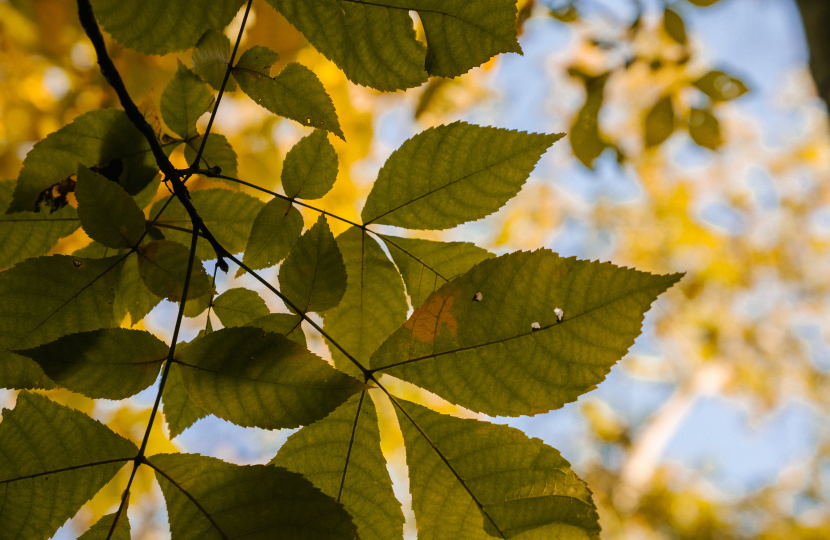
Sam Rowlands, Member of the Welsh Parliament for North Wales, shares information about how Flintshire County Council is dealing with dangerous ash trees.
Mr Rowlands, Shadow Minister for Local Government and a keen supporter of nature and looking after our environment said:
It is very sad to hear about the high number of ash trees which have been infected by the devastating fungal disease, Ash Dieback, as there is nothing that can be done to save these trees.
Flintshire council’s tree team is continuing to take targeted action to identify those infected and have a programme to fell diseased trees and plant new ones across the county.
I also support a call by the council reminding landowners that they also have a responsibility to ensure the safety of trees on their land.
Flintshire’s Tree Team are continuing to work to reduce the risk posed by dangerous ash trees which have been infected by Ash Dieback, which will see the death of around 90% of all the ash trees in the UK.
Following this summer’s county-wide ash dieback surveys, they have identified ash trees of concern and disease hotspots and will be targeting action in the areas of highest risk.
As with previous years, this tree felling programme will progress to removing council owned roadside infected ash trees and infected ash trees growing within schools, public open spaces and countryside parks.
There is nothing that can be done do to prevent the tree infection and subsequent tree loss. However, to mitigate these losses, Flintshire County Council will continue to plant new trees across the county, not only to replace the losses from Ash Dieback, but to establish new trees and woodlands to benefit biodiversity and contribute toward tackling the effects of climate change.
The council is also asking landowners, who also have a responsibility to ensure the safety of trees on their land, to take action if there is particular risk to the public from roadside trees, those adjoining other properties and those along public footpaths.
Sam Rowlands AS yn tynnu sylw at gamau sy'n cael eu cymryd gan gyngor Gogledd Cymru dros Glefyd Coed Ynn
Mae Sam Rowlands, Aelod o’r Senedd dros Ogledd Cymru, yn rhannu gwybodaeth am sut mae Cyngor Sir y Fflint yn delio â choed ynn peryglus.
Meddai Mr Rowlands, Gweinidog Llywodraeth Leol yr Wrthblaid a chefnogwr brwd dros fyd natur a gofalu am ein hamgylchedd:
Mae'n drist iawn clywed am y nifer uchel o goed ynn sydd wedi'u heintio gan y clefyd ffwngaidd dinistriol, Clefyd (Chalara) Coed Ynn, gan nad oes dim y gellir ei wneud i achub y coed hyn.
Mae tîm coed Cyngor Sir y Fflint yn parhau i gymryd camau wedi'u targedu i nodi'r rhai sydd wedi'u heintio a chael rhaglen i gwympo coed heintiedig a phlannu rhai newydd ar draws y sir.
Rwyf hefyd yn cefnogi galwad gan y cyngor yn atgoffa tirfeddianwyr bod ganddyn nhw gyfrifoldeb hefyd i sicrhau diogelwch coed ar eu tir.
Mae Tîm Coed Sir y Fflint yn parhau i weithio i leihau'r risg a achosir gan goed ynn peryglus sydd wedi'u heintio gan Glefyd Coed Ynn, a fydd yn arwain at tua 90% o'r holl goed ynn yn y DU yn marw.
Yn dilyn arolygon coed ynn ar draws y sir yr haf hwn, maen nhw wedi nodi coed ynn sy’n peri pryder a mannau problemus o ran clefydau a byddant yn targedu gweithredu yn yr ardaloedd sydd â'r risg uchaf.
Fel yn y blynyddoedd blaenorol, bydd y rhaglen cwympo coed hon yn symud ymlaen i gael gwared ar goed ynn wedi'u heintio ar ochr y ffordd sy'n eiddo i'r cyngor a choed ynn heintiedig sy'n tyfu mewn ysgolion, mannau agored cyhoeddus a pharciau cefn gwlad.
Nid oes unrhyw beth y gellir ei wneud i atal haint coed a cholli coed yn ddiweddarach. Fodd bynnag, er mwyn lliniaru'r colledion hyn, bydd Cyngor Sir y Fflint yn parhau i blannu coed newydd ar draws y sir, nid yn unig i ddisodli'r colledion yn sgil Clefyd Coed Ynn, ond i sefydlu coed a choetiroedd newydd er budd bioamrywiaeth a chyfrannu at fynd i'r afael ag effeithiau newid yn yr hinsawdd.
Mae'r cyngor hefyd yn gofyn i dirfeddianwyr, sydd hefyd â chyfrifoldeb i sicrhau diogelwch coed ar eu tir, gymryd camau os oes risg arbennig i'r cyhoedd o goed ar ochr y ffordd, y rhai sy'n ffinio ag eiddo eraill a'r rhai ar hyd llwybrau troed cyhoeddus.

